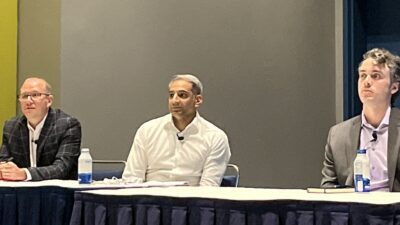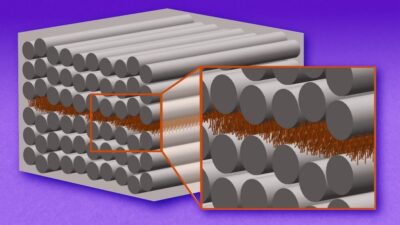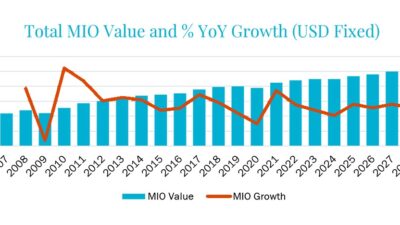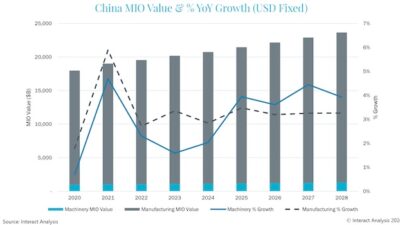Productivity has more than doubled in manufacturing in last 20 years, which is a boon for competitiveness, wages, and the rest of the economy, says Manufacturers Alliance/MAPI.
Anaheim, CA – U.S. policies make it tough for manufacturing to excel and yet manufacturing continues to drive economic growth. Jeremy Leonard, economist, with Manufacturers Alliance/MAPI, explained to a group of journalists and analysts on Nov. 10 that the U.S. has more manufacturing than any other country, despite higher costs and challenges in getting enough qualified engineers.
Leonard, part of the Rockwell Automation Manufacturing Perspectives program, the day before Automation Fair, said policies make it difficult for manufacturers to compete effectively. "We have to ensure offshoring happens for the right reasons, to support foreign markets. Manufacturing will grow faster than the overall U.S. economy growth." The idea that the U.S. doesn’t manufacturer anything here anymore is simply false, Leonard said.
"U.S. manufacturing is the engine for growth in the global economy , and I say this over and over again," he noted. Productivity in manufacturing is growing much faster than in the rest of the economy. Productivity has more than doubled in manufacturing in last 20 years, which is a boon for competitiveness, wages, and the rest of the economy, he said.
|
Manfuacturing is the U.S. growth engine , MAPI says. Also read: – Demand management during an economic downturn ; and |
MAPI, based in Arlington, VA, was founded in 1933, as Machinery and Allied Products Institute. MAPI has more than 500 companies as members, including Rockwell Automation. MAPI efforts include a quarterly economic forecast, released Nov. 10. Also in November is an annual update of the organization’s five year forecast. U.S. GDP at 3.5% for the third quarter, benefited from the stimulus package and the cash for clunkers program, Leonard said. Next two quarters will deliver anemic growth, perhaps 1%, he predicted.
Consumption spending continues to be hammered because of the housing bust and very weak labor markets, plus, unemployment was above 10% last month, Leonard said. In 2010 we’re looking at 0.5% growth. Why? Capacity utilization has plummeted to lows unseen since the Great Depression and that has to be filled before additional capacity is built, Leonard explained. Unemployment will remain at double digits through 2010, as companies seek a more firm confirmation of economic recovery, he predicted. Until then, they’re likely to be conservative with spending.
Leonard expressed no immediate concerns about inflation, saying he expects to see the U.S. Federal Reserve move interest rates higher toward end of 2010.
Of U.S. R&D investment, 70% goes to manufacturing, and it’s paid off with manufacturing holding 90% of U.S. patents, Leonard said. Manufacturing needs protection, since each $1 investment in manufacturing returns $1.37 in economic growth.
Grinning a bit, Leonard suggested that services cannot provide the economic benefits of manufacturing: "I don’t know who said it, but it’s true that we cannot add value to the U.S. economy by people giving themselves haircuts."
Manufacturing production has increased over the past last 20 years. While the share of overall U.S. employees in manufacturing has decreased, the volume of what’s manufactured has increased. More is being produced with fewer resources, which liberates resources for growth in others areas. I don’t think the information industry would exist if manufacturers weren’t producing more for less.
Concerns for U.S. manufacturing include high structural costs compared to trading partners, comprised of high corporate tax rates, health care costs, tort liability costs, and high cost of regulatory compliance. There’s a skilled labor shortage and the skills gap is projected to increase as the numbers of engineering degrees is down 20% since the mid-1980s. More troubling, 40% of ninth graders will lack skills for tomorrow’s manufacturing jobs.
Investment in R&D: 70% of R&D done by business depends on applied research done in federal labs, Leonard said.
What needs to be done? Multinationals should be able to locate jobs outside of U.S. to serve local businesses more cost effectively, but not only to send the goods back to the U.S. for sale, Leonard said, calling on policymakers and politicians to work with business leaders to make the U.S. business environment more efficient and friendly.
– Mark T. Hoske, electronic products editor, Manufacturing Business Technology , MBT www.mbtmag.com




